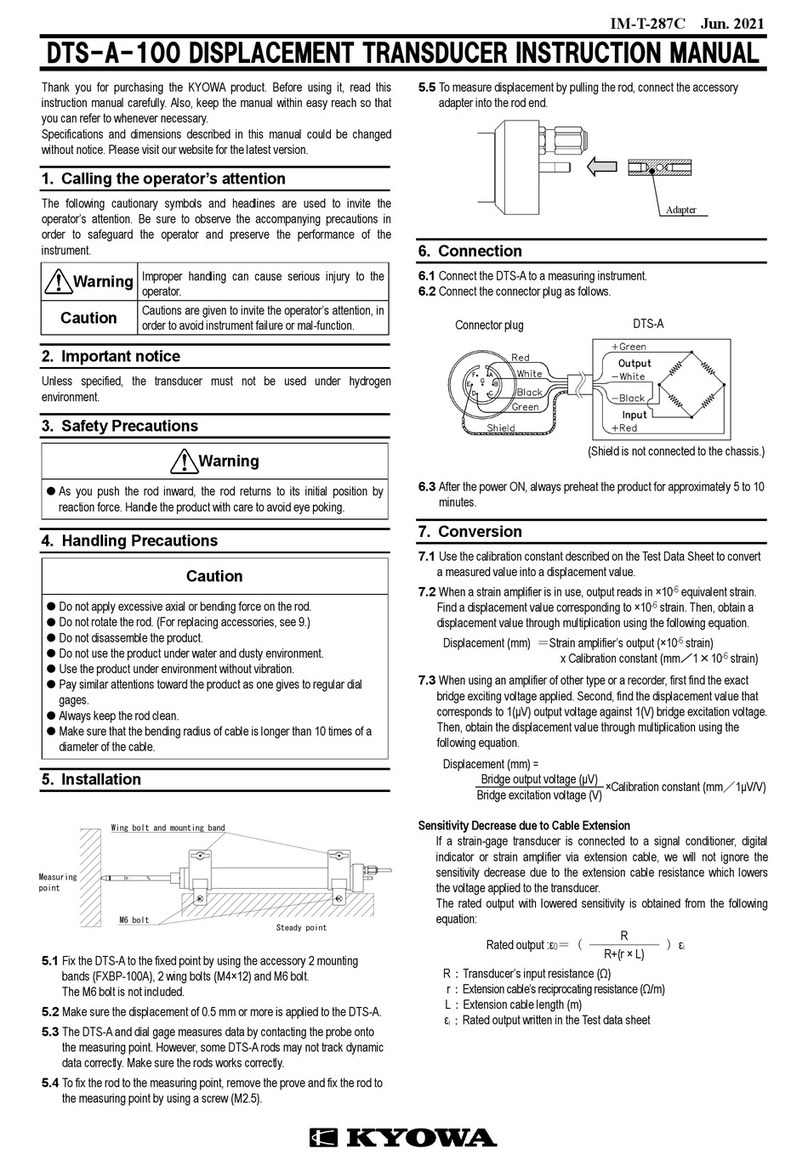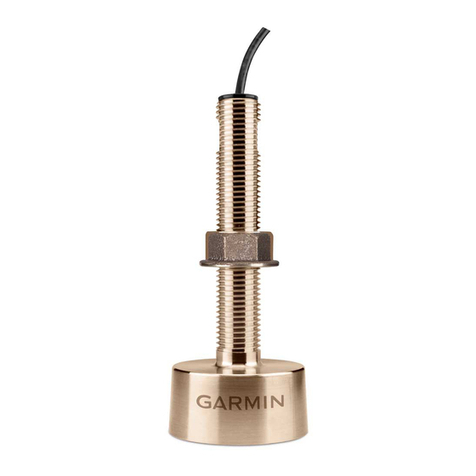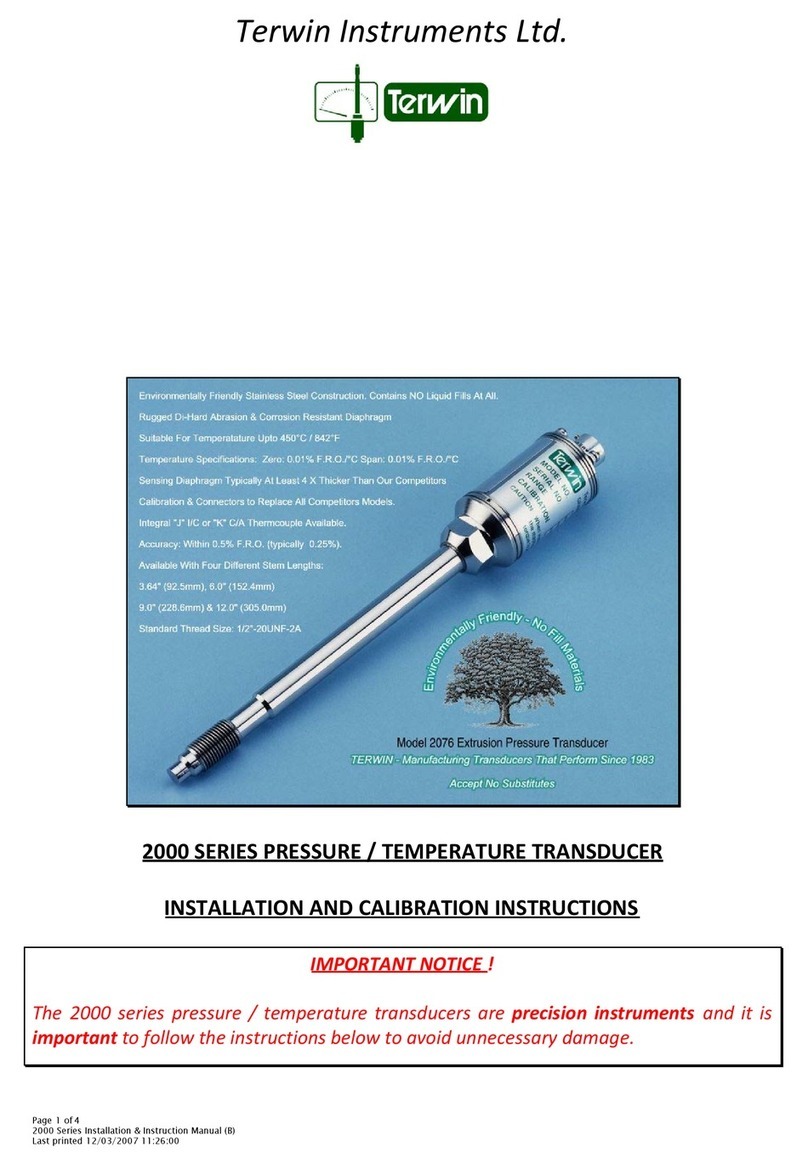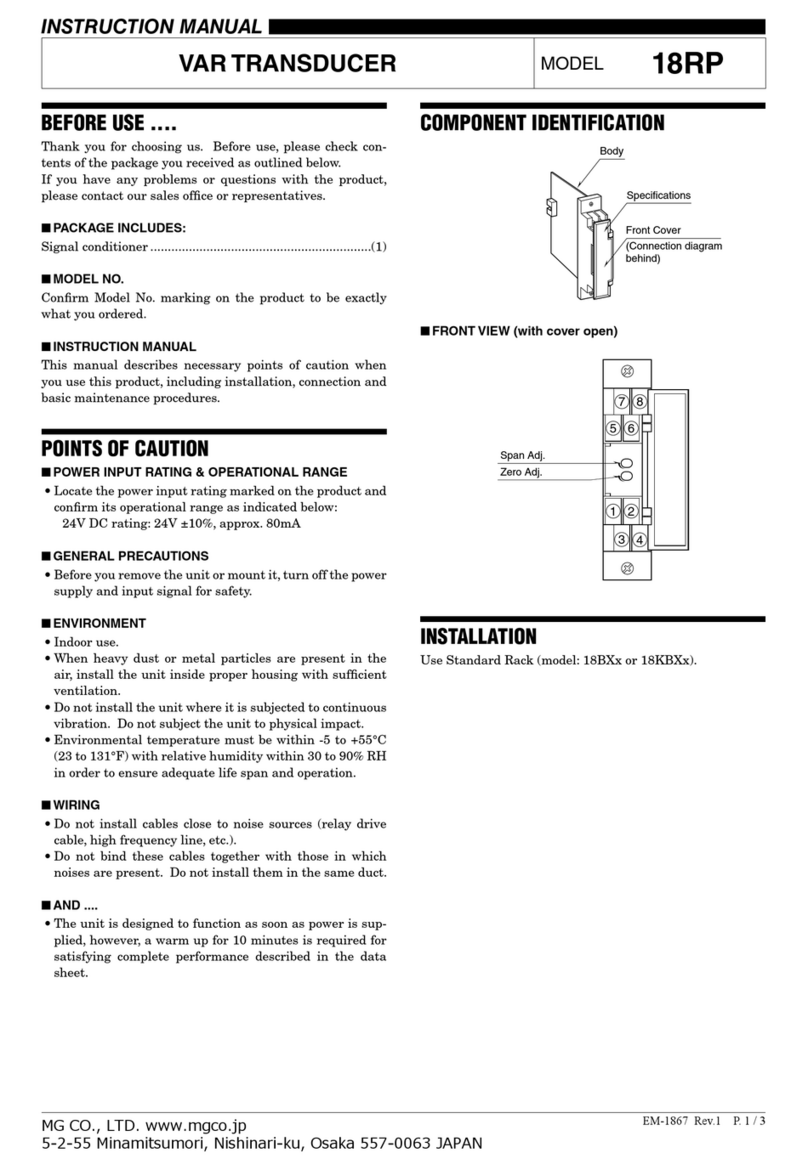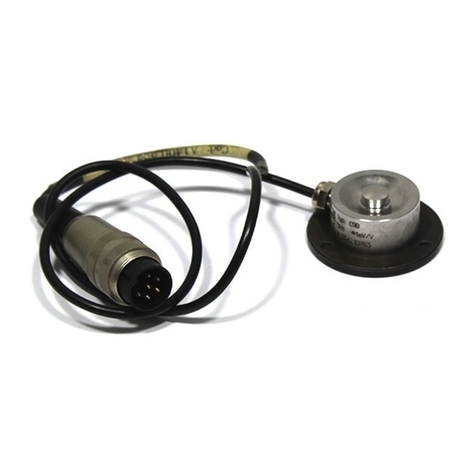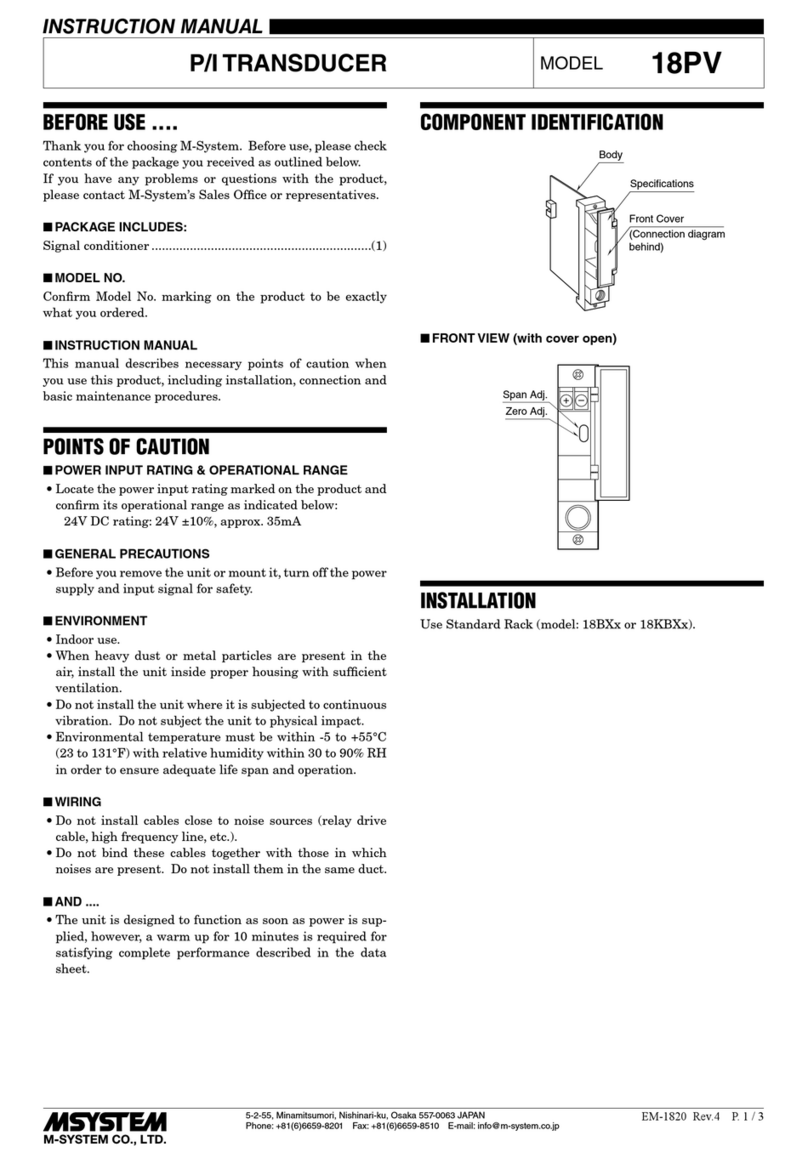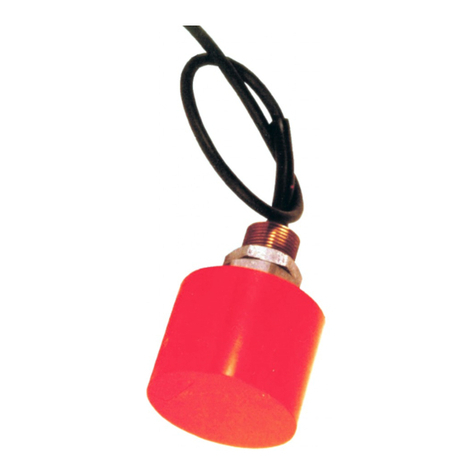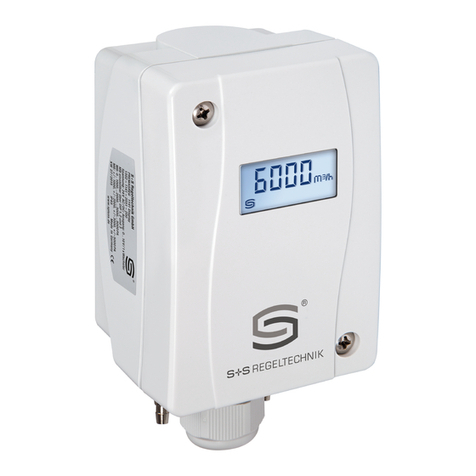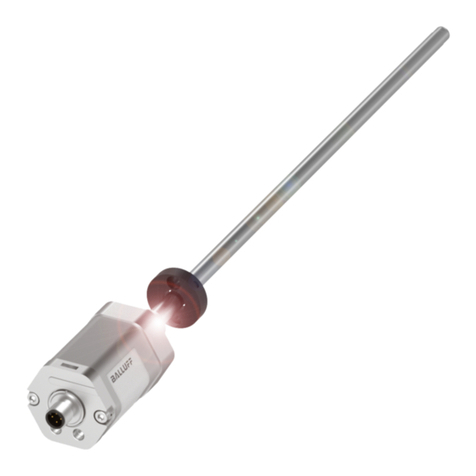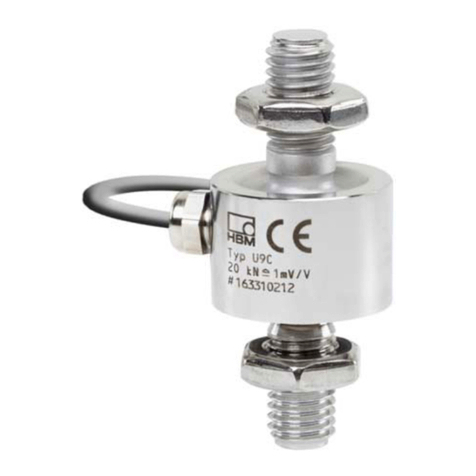BIOPAC Systems, Inc. MP150 Installation instructions

www.biopac.com 1
MP System Hardware Guide
The MP Hardware Guide describes how to connect and set up various signal conditioning and amplifier
modules for use with the MP System, and includes sections that detail different applications and uses for the
MP System.
9All specifications are subject to change without notice.
42 Aero Camino, Goleta, CA 93117
Tel (805) 685-0066 | Fax (805) 685-0067
www.biopac.com

2 MP System Hardware Guide
Chapter 1 MP Systems
The MP System is a computer-based data acquisition system that performs many of the same functions as a chart
recorder or other data viewing device, but is superior to such devices in that it transcends the physical limits
commonly encountered (such as paper width or speed). The MP data acquisition unit (MP150 or MP100) is the
heart of the MP System. The MP unit takes incoming signals and converts them into digital signals that can be
processed with your computer.
MP Systems can be used for a wide array of applications, including:
Cardiovascular Hemodynamics Evoked Response Plethysmography
ECG: Cardiology Exercise Physiology Psychophysiology
EEG: Electroencephalogram Interfacing with Existing Equipment Pulmonary Function
EMG: Electromyogram In vitro Pharmacology Remote Monitoring
EOG / Eye Movement Laser Doppler Sleep Studies
Data collection generally involves taking incoming signals (usually analog) and sending them to the computer,
where they are (a) displayed on the screen and (b) stored in the computer’s memory (or on the hard disk). These
signals can then be stored for future examination, much as a word processor stores a document or a statistics
program saves a data file. Graphical and numerical representations of the data can also be produced for use with
other programs.
Application Notes are provided at www.biopac.com under Support; see page 22223.
Quick Start Templates are provided in the Samples folder to simplify setup; see page 25.
The MP System can be used on a Macintosh®or on a PC with Windows®. The System utilizes the same hardware,
excepting hardware for computer interface. The software has the same “look and feel” on both the Macintosh®and
the PC.
MP150 STARTER SYSTEM
MP150 System includes:
Data acquisition unit: MP150A-CE
Universal interface module: UIM100C
Ethernet Switch (for user-supplied Ethernet
card or adapter): ETHSW1
Transformer: AC150A
Cables: CBLETH1 (2)
AcqKnowledge®software CD
*MP150 Specifications are on page 9.
The MP150 high-speed data acquisition system utilizes the very latest in Ethernet technology. The MP150 is
compliant with any Ethernet (DLC) ready PC or Macintosh. This next generation product takes full advantage of
cutting edge technology. Access multiple MP150 devices located on a local area network and record data to any
computer connected to the same LAN. Record multiple channels with variable sample rates to maximize storage
efficiency. Record at speeds up to 400 kHz (aggregate).
Recommended MP150 configuration:
For the best possible performance, connect the MP System solely to the computer’s Ethernet port. For simultaneous
connection of the network and the MP System, the ETHSW1 is required. If a computer has no Ethernet port, users
need to install an industry standard PCI Ethernet card (Intel, 3COM, etc.). If a computer does not require
simultaneous connection to the network, it’s acceptable to use a standard crossover Ethernet cable to connect the
MP System to a computer.

www.biopac.com 3
MP150 Symbology
Front panel See “Light Status” section for functionality details.
POWER Green light Indicates MP150 Power status.
ACTIVITY Amber light Indicates data traffic to or from MP150— similar to
Hard Disk activity light on any personal computer.
BUSY Green light Indicates MP150 data acquisition.
Back panel
Power ON Push in to power up the MP150
OFF Pop out to cut the flow of power to the MP150
IMPORTANT! The MP150 does not have a “Hardware Reset”
switch like your personal computer does. To reset the MP150 for any
reason, just click the power switch twice.
Fuse 2A 2 Amp fast-blow fuse holder; the maximum capacity of the fuse is 2 Amps.
To remove the fuse, use a screwdriver to remove the fuse cover,
which is located below the word Fuse.
DC Input Use the DC Input to connect a battery, AC/DC converter or other power
supply to the MP150.
The MP150 requires 12 VDC @ 2 Amps
The receptacle can accept a “+” (positive) input in the center of the
connector and a “−” (negative) input on the connector housing.
Serial port The MP150 can connect to the computer via a serial port, located just below
the word Serial (this connection is not normally used).
Uses a standard MINI DIN 8 connector.
Should only be used to connect the MP150 to a PC (via USB1W) or
Mac (via USB1M).
Ethernet The MP150 connects to the computer via a serial port, located just below
the word Ethernet.
Uses a standard RJ-Ethernet connector (10 base T).
Side panel
Module
connections The two connector inputs are designed to connect directly to the UIM100C.
Analog signals are transmitted through the 37-pin connector (upper right side)
Digital signals are transmitted through the 25-pin connector (lower-right side)
Bottom
Firmware
Rollback Switch IMPORTANT! This is NOT A RESET SWITCH
The Firmware Rollback Switch is located on the bottom of the MP150 unit and is
recessed to prevent accidental activation—it is NOT A RESET for the MP150 unit.
Warning! Activation of the Firmware Rollback Switch will cause the MP150 unit to
operate under the previous version of firmware loaded into the unit. Refer to Appendix F
of the AcqKnowledge Software Guide for procedural details.

4 MP System Hardware Guide
ACTIVITY
BUSY MODE DESCRIPTION
A Bright
B Bright
Self-Test
Work
Error
ACTIVITY and BUSY be bright for the duration of the self-test and setup process.
This may take 3 – 10 seconds, depending on MP150 internal memory.
During data acquisition, ACTIVITY reflects command/data traffic (for acquisition
speeds of 1000 Hz or more, ACTIVITY will be permanently bright or blink at a high
frequency) and BUSY will be bright. It is normal for both lights to be on—this does
not indicate a problem unless you receive an Error Message on the computer screen.
ERROR: In rare cases, a serious problem may prevent a self-test and the lights may be
erratic: both on, both off, or any other static combination.
A Bright
B Blink
Error The MP150 enters the Error Mode if a fatal error occurs during the Self-test Mode. In
the Error Mode, ACTIVITY is bright and BUSY is blinking at a frequency of 5 Hz.
A Blink
B Bright
Error If the self-test fails or setup fails, the Error mode is initiated and ACTIVITY will blink
at about 5 Hz rate and BUSY will remain bright.
A Blink
B off Idle-1
Idle-2
ACTIVITY blinks twice with approximately 1.5-2 second interval and BUSY is OFF.
Double blink means:
-MP150 may be disconnected from LAN or,
-MP150 is connected to LAN but did not receive IP address from network’s
DHCP server and default 169.254.xxx.xxx address is self-assigned to MP150.
This is the standard state for MP150 connected to NIC through cross-over
network cable.
It means the MP150 is in working condition and ready for acquisition. AcqKnowledge
may communicate with the MP150 through a serial cable or through a network by
using 169.254.xxx.xxx address and/or cross-over cable.
ACTIVITY blinks once with approximately 1.5-2 second interval and BUSY is OFF.
Single blink means:
-MP150 is connected to LAN and received IP address from network’s DHCP
server.
It means the MP150 is in working condition and ready for acquisition.
A off
B off
Self-Test
Wait
Error
ACTIVITY and BUSY will go dark for less than 1 second at the end of the self-test
before proceeding to the Idle mode.
Under some conditions, such as when you have a dialog box open, AcqKnowledge
cannot send commands to the MP150. When command flow from the workstation
stops, the MP150 acts as if you have an open dialog and enters the Wait Mode to wait
for a command from the workstation it is “locked” to—commands from any other
work station will be ignored. When it receives a command, the MP150 return to the
Work mode. After five minutes with no command communication, the MP150 will
revert to the Idle mode.
ERROR: In rare cases, a serious problem may prevent a self-test and the lights may be
erratic: both on, both off, or a static combination.

www.biopac.com 5
Startup (Power ON) > Self-test
When the MP150 is turned ON, ACTIVITY and
BUSY will shine for the duration of the self-test
and setup process. This may take 3 – 10 seconds,
depending on MP150 internal memory.
Error
The MP150 enters the Error Mode
if a fatal error occurs during the
Self-test Mode.
Idle
MP150 is waiting for any
command/request from
AcqKnoweldge or any workstation
or any interface. [See Note 1]
Work
MP150 receives/sends
commands/data to/from
AcqKnowledge. [See Note 2]
Wait
MP150 cannot receive command
due to software condition (i.e.,
dialog box open). [See Note 3]
MP150 STATUS LIGHT PATHS
NOTES
1. IDLE—Both light patterns are normal and indicate that the MP150 is waiting for a command—neither
indicates a problem with the MP150. The MP150 can switch between Idle-1 and Idle-2. Idle-1 or Idle-2
pattern indicates which IP address the MP150 is using:
•Idle-1: self-assigned address in 169.254.xxx.xxx network
•Idle-2: address from DHCP server).
2. WORK — When the MP150 receives any command from any workstation, it locks on to that workstation
and communicates with it exclusively. The MP150 “remembers” the active workstation and will ignore
commands from any other workstation. The MP150 usually remains in the Working Mode until you quit the
AcqKnowledge software.
3. WAIT — Under some conditions, such as when you have a dialog box open, AcqKnowledge cannot send
commands to the MP150. When command flow from the workstation stops, the MP150 acts as if you have
an open dialog and enters the Wait Mode to wait for a command from the workstation it is “locked” to—
commands from any other work station will be ignored. When it receives a command, the MP150 enters the
Work mode; if the MP150 does not receive a command within five minutes, it reverts to Idle.
Work
MP150 receives/sends
commands/data to/from
AcqKnowledge. [See Note 2]

6 MP System Hardware Guide
MP150A-CE Data Acquisition Unit Block Diagram
The MP150 has an internal microprocessor to control the data acquisition and communication with the computer.
There are 16 analog input channels, two analog output channels, 16 digital channels that can be used for either input
or output, and an external trigger input. The digital lines can be programmed as either inputs or outputs and function
in 8 channel blocks. Block 1 (I/O lines 0 through 7) can be programmed as either all inputs or all outputs,
independently of block 2 (I/O lines 8 through 15).
MP150A-CE block diagram
*MP150 Specifications are on page 9.

www.biopac.com 7
MP100 STARTER SYSTEM
*MP100 Specifications are on page 9.
The MP100 system offers USB-ready data acquisition and analysis. Record multiple channels with differing sample
rates. Record at speeds up to 70 kHz or 16 kHz (aggregate to disk)
MP100 System includes:
Data acquisition unit: MP100A-CE Transformer: AC100A
Universal interface module: UIM100C Cables: CBLSERA cable, CBLS100 cable set
USB adapter: USB1W (PC) or USB1M (Macintosh) AcqKnowledge®software CD
Recommended MP100 configuration:
For the best possible performance, connect the MP System to the computer’s USB port, with no other USB traffic
intensive devices (e.g. scanners, hard drives, cameras) running simultaneously. If a computer has no USB port, users
need to install an industry standard PCI USB card.
MP100 Symbology
Front panel
POWER Power status
On if MP100 is turned ON.
Off if MP10 is turned OFF.
BUSY MP100 acquisition status
On during acquisition or during the first 1-5
seconds after the MP100 is powered ON.
CABLE
INPUTS 25-pin cable connection Digital signals
37-pin cable connection Analog signals
Back panel
Power switch On powers up the MP100
Off cuts the flow of power to the MP100
Fuse holder Next to the power switch is a 2 Amp fast-blow fuse holder.
To remove the fuse, use a screwdriver to remove the fuse cover,
which is located below the word Fuse.
The maximum capacity of the fuse is 2 Amps.
Back panel cont’d
DC Input The DC Input, located between the fuse holder and the serial cable, is where a
battery, AC/DC converter or other power supply connects to the MP100.
The power supply requirements for the MP100 are 12 VDC @ 1 Amp,
The receptacle is configured to accept a “+” (positive) input in the center of the
connector and a “−” (negative) input on the connector housing.
Serial port The MP100 connects to the computer via a serial port, located just
below the word Serial.
Uses a standard MINI DIN 8 connector.
Should only be used to connect the MP100 to a PC or Macintosh.

8 MP System Hardware Guide
MP100A-CE Data Acquisition Uni Block Diagram
The MP100 has an internal microprocessor to control the data acquisition and communication with the computer.
There are 16 analog input channels, two analog output channels, 16 digital channels that can be used for either input
or output, and an external trigger input. The digital lines can be programmed as either inputs or outputs and function
in 8 channel blocks. Block 1 (I/O lines 0 through 7) can be programmed as either all inputs or all outputs,
independently of block 2 (I/O lines 8 through 15).
MP100 block diagram
*MP100 Specifications follow.

www.biopac.com 9
MP System Specifications — for MP150 and MP100
MP150 and MP100 Data Acquisition Unit Specifications:
Analog Inputs
Number of Channels: 16
Input Voltage Range: ±10V
A/D Resolution: 16 Bits
Accuracy (% of FSR): ±0.003
Input impedance: 1.0 MΩ
Analog Outputs
Number of Channels: 2
Output Voltage Range: ±10V
D/A Resolution: MP150: 16 bits, MP100: 12 Bits
Accuracy (% of FSR): MP150: ±0.003, MP100: ±0.02
Output Drive Current: ±5mA (max)
Output Impedance: 100Ω
Digital I/O
Number of Channels: 16
Voltage Levels: TTL, CMOS
Output Drive Current: ±20mA (max)
External Trigger Input: TTL, CMOS compatible
Time Base
Min Sample Rate: 2 samples/hour
Trigger Options: Internal, External or Signal Level
Power
Amplifier Module Isolation: Provided by the MP unit
CE Marking: EC Low Voltage and EMC Directives
Leakage current: <8µA (Normal), <400µA (Single Fault)
Fuse: 2A (fast blow)
Device specific specs MP150A MP100A
Max Sample Rate
MP Internal Memory:
200K samples/sec (400K aggregate)
70K samples/sec (70 K aggregate)
PC Memory/Disk: 200K samples/sec (400K aggregate) 11K samples/sec (16K aggregate)
Internal Buffer Size: 6M samples 16K samples
Serial Interface Type/Rate: Ethernet: DLC type I (10M bits/sec)
Serial: RS422 (800K bits/sec)
Serial: RS422 (800 Kbits/sec)
Transmission Type: Ethernet USB only (PC via USB1W or
Macintosh via USB1M)
Maximum cable length: 100 meters (Ethernet cable) 7 meters (USB + SERIAL cable)
Power Requirements: 12VDC @ 2 amp (uses AC150A) 12 VDC @ 1amp (uses AC100A)
Dimensions: 10cm x 11cm x 19cm 7cm x 29cm x 25cm
Weight: 1.0 kg 1.8 kg
OS Compatibility
Ethernet Interface
PC
Macintosh
USB Interface
PC
Macintosh
Windows 98, 98SE, 2000, NT 4.0
System 8.6 or better
Not supported
Not supported
Not supported
Not supported
Windows 98, 98SE, 2000
System 8.6 or better
Application Programming Interfaces options:
•Hardware Interface BHAPI
•Software Interface ACKAPI

10 MP System Hardware Guide
Isolation
Designed to satisfy the following Medical Safety Test Standards affiliated with IEC601-1:
Creepage and Air Clearance
Dielectric Strength
Patient Leakage Current
Contact BIOPAC for additional details.
Signal conditioning module compatibility
CO2100C EGG100C HLT100C PPG100C
DA100C EMG100C LDF100C RSP100C
EBI100C EOG100C MCE100C SKT100C
ECG100C ERS100C O2100C STM100C
EEG100C GSR100C OXY100C TEL100C
Cleaning procedures
Be sure to unplug the power supply from the MP150/100 before cleaning. To clean the MP150/100, use a
damp, soft cloth. Abrasive cleaners are not recommended as they might damage the housing. Do not
immerse the MP150/100 or any of its components, as this can damage the system. Let the unit air-dry until
it is safe to reconnect the power supply.
AC150/100A Power Supplies
The 12-volt in-line switching transformer connects the MP unit to the AC mains wall outlet. One
transformer is included with each MP System; replacements can be ordered separately.

www.biopac.com 11
MP SYSTEM PIN-OUTS —FOR MP150 AND MP100
Digital DSUB 25 (male) Pin-outs
17 18 19
1 2 3 4 5
23 24 25
10 11 12 13
6 7 8 9
14 15 16 20 21 22
DIGITAL
Pin Description Pin Description
1 I/O 0 14 I/O 4
2 I/O 1 15 I/O 5
3 I/O 2 16 I/O 6
4 I/O 3 17 I/O 7
5 GND D 18 GND A
6 GND D 19 Out 1
7 EXT T 20 Out 0
8 +5 VD 21 GND A
9 +5 VD 22 I/O 12
10 I/O 8 23 I/O 13
11 I/O 9 24 I/O 14
12 I/O 10 25 I/O 15
13 I/O 11
Analog DSUB 37 (male) Pin-outs
29 30 31
1 2 3 4 5 6 7 8 9 10 11 12 13 14 15 16 17 18 19
26 27 2820 21 22 23 24 25 32 33 34 35 36 37
ANALOG
Pin Description Pin Description
1 GND A 20 CH 1
2 GND A 21 CH 2
3 GND A 22 CH 3
4 GND A 23 CH 4
5 GND A 24 CH 5
6 GND A 25 CH 6
7 GND A 26 CH 7
8 GND A 27 CH 8
9 +12 V 28 +12 V
10 GND A 29 - 12 V
11 -12 V 30 CH 9
12 GND A 31 CH 10
13 GND A 32 CH 11
14 GND A 33 CH 12
15 GND A 34 CH 13
16 GND A 35 CH 14
17 GND A 36 CH 15
18 GND A 37 CH 16
19 GND A

12 MP System Hardware Guide
Serial MINI DIN 8 (female) Pin-outs
SERIAL
Pin Description
1 No Connection
2 Clock (MP Output)
3 Rx+ (MP Input)
4 GND computer
5 Tx+ (MP Output)
6 Rx- (MP Input)
7 No Connection
8 Tx- (MP Output)
Ethernet connector Pin-outs (for model MP150 only)
Pin Description
1 TXD+
2 TXD-
3 RXD+
4 No Connection
5 No Connection
6 RXD-
7 No Connection
8 No Connection

www.biopac.com 13
Cleaning & Disinfecting BIOPAC Components
The following disinfectants are recommended for LIQUID “COLD” sterilization of BIOPAC transducers:
•Cidex®OPA Disinfectant Solution, Johnson & Johnson
•Perform®Powder Disinfectant Concentrate, Schülke & Mayr
•Terralin®, Liquid Disinfectant Concentrate, Schülke & Mayr
AFT25 Facemask
•See detailed guide shipped with the product; also available at www.biopac.com.
EL250 Series Electrodes
•Store electrodes in clean, dry area.
•After use, clean electrode with cold to tepid water
•DO NOT use hot water.
•Cotton swabs are suggested.
•Let the electrode dry completely before storing it.
•DO NOT allow the electrodes to come in contact with each other during storage.
•Electrodes may form a brown coating if they have not been used regularly. To remove the coating,
gently polish the surface of the electrode element with non-metallic material or wipe it with mild
ammonium hydroxide. Rinse with water and store the electrode in a clean, dry container.
GASSYS2
•See page 246 or detailed guide shipped with the product; also available at www.biopac.com.
LDF100C
•See page 175.
Probes
•Immersion temperature probes can be cleaned using standard liquid disinfectant methods, with
direct immersion for the recommended period.
•Non-immersion probes can be wiped down with liquid disinfectant or alcohol.
RX137 Series Airflow Heads
•Thorough cleaning retains precise measurements. Disinfecting is only useful on a previously
cleaned apparatus. Using a gas for disinfecting does not provide cleaning. An appropriate
disinfectant solution can clean and disinfect simultaneously.
1. Immerse the apparatus in the liquid. It can be completely immersed since the electrical part
is waterproof; a 30- to 60-minute bath is usually sufficient to detach or dissolve the dirt.
2. Rinse under a strong tap.
3. Rinse with distilled or demineralized water.
4. Use air or another compressed gas to dry the apparatus. Blow through the screen and in
each pressure tube; a pressure of 5 to 6 bars is acceptable.
5. Finish drying with atmospheric air or with a warm blow dryer (hair dryer).
•WARNING!
Do not use organic solvents Dilute the disinfectant (as for hand washing)
Do not heat the apparatus above 50ºC Never touch the screen with a tool
•Examples of liquids that may be used: Cidex, Glutaral, Glutaraldéhyde
•Example of gas that may be used: Ethylene oxide
TSD130 Series Goniomoters & Torsiometers
•Important: Disconnect sensors from instrumentation before cleaning or disinfecting.
•Cleaning: Wipe the sensors with a damp cloth, or a cloth moistened with soapy water. Do not use
solvents, strong alkaline or acidic materials to clean the sensors.
•Disinfection: Wipe the sensors with a cloth moistened with disinfectant.
TSD140 Probes
•See page 175.
Always follow the
manufacturer’s directions.

14 MP System Hardware Guide
Magnetic Resonance Imaging and MP System Components
MRI-compatibility Statement
“Radiotranslucent” and “MRI-compatible” products are ones which are brought into the MRI Chamber
room. All other BIOPAC products can be brought into the MRI control room, as this room is not subject to
the high field gradients in the MRI.
BIOPAC defines “Radiotranslucent” products as products that have no thermally or electrically conductive
metal and no robustly magnetically susceptable materials (ie. Ferromagnetic, Ferrimagnetic) in the applied
part. These products may include electrically conductive materials (i.e. carbon fiber, electrode gel), but due
to relatively low instrinic electrical conductance, self-heating effects due to eddy currents are typically
minimal. These products are best suited for MRI and fMRI applications.
BIOPAC defines “MRI-compatible” products as products that have some thermally and electrically
conductive metals, but no robustly magnetically susceptable materials (i.e. Ferromagnetic, Ferrimagnetic)
in the applied part. These may be suitable for some MRI and fMRI applications. Because these products
include some relatively high thermal and electrically conductive components, self-heating effects due to
eddy currents can become problematic. In cases where this problem manifests, some consideration to
thermal insulation from the thermally and electrically conductive applied part to the subject is relevant.
BIOPAC defines “Radio-opaque” products as products whose applied part is easily visible in an x-ray
machine viewer so it can be better manipulated. Radiotranslucent in this context implies that the applied
part is only partially or not visible in the x-ray viewer. Radio-opaque products are not necessarily suitable
for use in MRI or fMRI applications.
MRI Components
MRI Cable/Filter Sets The table below illustrates the components of each cable/filter set. See below
for full descriptions of each included cable and filter.
Cable/Filter Sets
MRIRFIF
MRIRFIF-2
MECMRI-1
MECMRI-2
MECMRI-3
MECMRI-4
MECMRI-5
MECMRI-6
MECMRI-DA — For recordings
with a transducer in the MRI
chamber room and the DA100C
in the MRI control room. Use to
connect directly to the following
transducers: Medium Flow
Pneumotach (TSD117-MRI) or
Hand clench dynamometer
(TSD121B-MRI).
X
X
MECMRI-HLT —For
recordings in the MRI with the
HLT100C. Use to connect
directly to the following
transducers: TSD115-MRI or
TSD131-MRI.
X
X
MECMRI-OXY —Use to
connect to the OXY100C Pulse
Oximeter and TSD123A/B
Oximetry transducers for MRI
applications.
X

www.biopac.com 15
Cable/Filter Sets
MRIRFIF
MRIRFIF-2
MECMRI-1
MECMRI-2
MECMRI-3
MECMRI-4
MECMRI-5
MECMRI-6
MECMRI-STMISO —Use to
connect directly to the
following stim isolation
adapters: STMISOC,
STMISOD, or STMISOE.
X
X
X
MECMRI-TRANS —For
Transducer recordings in the
MRI. Use to connect directly to
the following transducer
amplifiers: GSR100C,
PPG100C, RSP100C, or
SKT100C.
Connection Sequence: Subject
to transducer to MECMRI-1 to
MRIRFIF to MECMRI-3 to
transducer module.
X
X X
MECMRI-BIOP —
Component set for Biopotential
recordings in the MRI. Use to
connect directly to any of the
following biopotential
amplifiers: ECG100C,
EEG100C, EGG100C,
EMG100C, EOG100C,
ERS100C.
Connection Sequence: Subject
to electrodes to leads to
MECMRI-1 to MRIRFIF to
MECMRI-2 to Biopotential
Module
X
X X

16 MP System Hardware Guide
MRIRFIF
MRIRFIF is a five-line Pi filter set, designed for interfacing between the
MECMRI-1 chamber room cable and any of the MRI control room cables
(MECMRI2-MECMRI6).
See also: App Note 223 Physiological Measurements in Magnetic Resonance
Imaging Systems Using BIOPAC Equipment.
•MRIRFIF: -3 dB point = 100 kHz
•MRIRFIF-2: -3 dB point = 1 MHz
•MRIRFIF + MRIRFIF-2 = 3 dB point = 70 kHz
oattenuation is -60 db from 7 MHz to 1,000 MHz
oattenuation slope from 70 kHz to 7 Mhz is 30 dB per decade
This Pi filter set has a dielectric withstand voltage of 1,500 VDC and is thus
compatible with IEC 60601-1 requirements. The Pi filter set is designed to
shunt RF energy from the MRI or control room chambers to EARTH
GROUND without sacrificing CMRR performance for the recording of small
valued biopotential or transducer signals.
The MRIRFIF’s symmetrical construction, with dual 9-pin female
connectors, results in a pin swap for pins 1, 2, 3, 4, 5, regarding signal flow
as illustrated here:
Accordingly, if the MRIRFIF and associated cable assemblies (such as
MECMRI-#) are used with any existing patch panel connectors, the existing
connector must be a male/female 9-pin straight-through DSUB patch or filter
connector. The male side of the existing connector must be on the Control
room side to successfully connect the MRIRFIF to this connector.
Best performance is obtained by robustly attaching the GROUND of the
MRIRFIF (metal enclosure) to EARTH GROUND at the junction panel.
Mounting the MRIRFIF to the junction panel via the included L-bracket
establishes an excellent ground to the panel. EARTH GROUND must be
robust and held to the same potential as MAINS GROUND.
Leakage Currents
The IEC 60601-1 standard specifies a leakage current of 5 ma assuming
double fault conditions. 265 VAC at 60 Hz will source 5 ma into a reactance
of 53 K. This reactance is equivalent to an effective subject capacitance to
equipment ground of 0.05 uF. The BIOPAC MP unit establishes a subject to
ground capacitance of 0.005 uF. The Pi filter set (MRIRFIF + MRIRFIF-2)
incorporates a 0.003 uF subject capacitance to ground. Accordingly, even
with 15 MECMRI cables—with 15 MRIRFIFs—this results in a capacitance
of .05 uF, which is 100% of the IEC 60601-1 limit, assuming mains is 265
VAC at 60 Hz.

www.biopac.com 17
MRIRFIF-2
This filter has a dielectric withstand voltage of 1,500 VDC and is compatible
with IEC60601-1 requirements. The filter is designed to shunt RF energy
from the MRI or control room chambers to EARTH GROUND without
sacrificing CMRR performance for the recording of small valued signals.
•MRIRFIF-2: -3 dB point = 1 MHz
This nine-line Pi filter is designed for interfacing between the MRI chamber
room cable (MECMRI-OXY) and the MRI control room cable (OXY-MRI).
If the MECMRI-OXY set is used with an existing patch panel connector, the
MRIRFIF-2 should be plugged into the Control Room side of the patch panel
connector, which must be a male/female 9-pin straight-through DSUB patch
or filter connector. The male side of the existing connector must be on the
Control room side to successfully connect to the MRIRFIF-2 and OXY
cables.
Best performance is obtained by robustly attaching the GROUND of the
MRIRFIF-2 (metal enclosure) to EARTH GROUND at the junction panel.
Mounting the MRIRFIF-2 to the junction panel establishes an excellent
ground to the panel. EARTH GROUND must be robust and held to the same
potential as MAINS GROUND.
Leakage Currents
The IEC 60601-1 standard specifies a leakage current of 5 ma assuming
double fault conditions. 265 VAC at 60 Hz will source 5 ma into a reactance
of 53 K. This reactance is equivalent to an effective subject capacitance to
equipment ground of 0.05 uF. The BIOPAC MP unit establishes a subject to
ground capacitance of 0.005 uF, and the Pi filter (MRIRFIF-2) incorporates a
0.0018 uF subject capacitance to ground. Accordingly, even with 16
MECMRI cables with 16 MRIRFIFs, this results in a capacitance of .0338
uF, which is 68% of the IEC 60601-1 limit, assuming mains is 265 VAC at
60 Hz.
MECMRI-1
This is a Biopotential or Transducer cable for use inside the MRI chamber
room. It supports one to five subject or transducer electrical connections and
is 8 meters long. The cable incorporates a plastic housed DSUB9 Male
connector to panel mount with the chamber room exposed DSUB9 female
connector of the MRIRFIF.
MECMRI-2
This is a Biopotential cable for use inside the MRI control room. It supports
one to five subject electrical connections and is 2 meters long. The cable
incorporates a plastic housed DSUB9 Male connector to panel mount with
the control room exposed DSUB9 female connector of the MRIRFIF. This
cable connects directly to any of the following biopotential amplifiers:
ECG100C, EEG100C, EGG100C, EMG100C, EOG100C, ERS100C.
MECMRI-3
This is a Transducer cable for use inside the MRI control room. It supports
one- to three-subject transducer connections and is 2 meters long. The cable
incorporates a plastic housed DSUB9 Male connector to panel mount with

18 MP System Hardware Guide
the control room exposed DSUB9 female connector of the MRIRFIF.
•This cable connects directly to any of the following transducer
amplifiers: GSR100C, PPG100C, RSP100C, SKT100C.
MECMRI-4
This cable is used inside the MRI control room. It supports one channel of
subject stimulator connection and is 2 meters long. The cable incorporates a
plastic housed DSUB9 Male connector to panel mount with the control room
exposed DSUB9 female connector of the MRIRFIF interference filter. This
cable connects directly to any of the following stim isolatation adapters:
STMISOC, STMISOD, or STMISOE.
Note One MECMRI-4 comes with the MECMRI-STIMISO setup kit.
MECMRI-5
This 2-meter cable is used inside the MRI control room. It supports one
channel of general-purpose transducer output and connects directly to the
DA100C high-level transducer module and the MRIRFIF interference filter.
Cable incorporates a plastic housed DSUB9 male connector to panel mount
with the control room exposed DSUB9 female connector of the MRIRFIF
interference filter.
Note One MECMRI-5 is included with the MECMRI-DA setup kit.
MECMRI-6
This cable is used inside the MRI control room. It supports one channel of
high-level transducer output and is 2 meters long. The cable incorporates a
plastic housed DSUB9 Male connector to panel mount with the control room
exposed DSUB9 female connector of the MRIRFIF interference filter. This
cable connects directly to the HLT100C high level transducer module.
Note One MECMRI-6 is included with the MECMRI-HLT setup kit.
OXYMRI
Use this 8-meter MRI chamber room cable for one channel of pulse oximeter
connection via TSD123A or TSD123B. One end terminates in a connector
that accepts the TSD123A or the TSD123B; the other end terminates in a
plastic-housed DSUB9 male connector to panel mount with the chamber
room exposed DSUB9 female connector of the MRIRFIF-2 interference
filter.
MECMRI-OXY
This 2-meter MRI control room cable provides one channel of connection to
the OXY100C. One end terminates for connection to the OXY100C; the other
end terminates in a plastic-housed DSUB9 male connector to panel mount
with the control room exposed DSUB9 female connector of the MRIRFIF-2
filter.
Setup Guidelines
See App Note AH-223 Physiological Measurements using BIOPAC in MRI Systems
App Note AH-230 Connections for Physiological Signals in an MRI
Contact BIOPAC if you have questions regarding set up and grounding to maintain subject
safety in accordance with IEC 60601-1.

www.biopac.com 19
Leakage Currents
The IEC 60601-1 standard specifies a leakage current of 5 ma assuming double fault conditions. 265
VAC at 60 Hz will source 5ma into a reactance of 53 K. This reactance is equivalent to an effective
subject capacitance to equipment ground of 0.05uF. The BIOPAC MP unit establishes a subject to
ground capacitance of 0.005 uF. The Pi filter (MRIRFIF) incorporates a 0.002uF subject capacitance to
ground (2 of 0.001 uF caps). Accordingly, even with 16 MECMRI cables—with 16 MRIRFIFs—this
results in a capacitance of .037 uF, which is 74% of the IEC 60601-1 limit, assuming mains is 265 VAC
at 60 Hz.
General recommendations for use:
Try to use pressure-based measurements in the MRI whenever possible, given the option. These
measurements are very safe and they are instrinsically radio translucent and they do not couple EMI...plus
they are always less expensive to implement. Pressure based measurements can record many physiological
variables (finger tapping pressure, blood pressure, pulse, hand grip strength, variable assessment,
heartsounds, body movements, smiling/frowning)
Where possible, couple all electrical signals via MECMRI cables.
Recommendations for specific applications:
•Airflow
ohigher airflow: use AFT21 or AFT22 or AFT25 with lots of AFT7 or AFT12 tubing to
TSD117 (in Control room)
olow airflow use TSD127 with dual AFT30 tubing to TSD160A (in Control room)
•Biopotential recording: use LEAD108A and EL508.
•Blood pressure, use RX-120 series, with dual AFT30 Tubing and TSD104A (in Control Room)
•Blood Volume Pulse and O2SAT: use TSD123A or TSD123B, with special extension to 9 pin
patch D-filter and custom cable to OXY100C...no MECMRI specific cable needed (custom)
•Finger twitch, use SS61L (w/long cable) to MRIRFIF to custom cable to DA100C.
•For GSR measurements, use LEAD108A to record via:
oelectrodes: EL507 or EL508 (hypersaturated-gel electrodes) or EL509 (dry electrode and
add gel).
oor transducer: TSD203 with GEL101
•Hand strength (dynamometry), use SS25LA (w/long cable) to MRIRFIF to custom cable to
DA100C
•Laser Doppler Flow measurements have the problem of proximity of LDF unit to magnet (only 2
meters), so these are best used when short distances can be tolerated from MRI to LDF unit. This
would be the case with smaller bore magnets, which are used for animal work. The best choices
here are the disposable probes because they will provide extra length, with disposable fiber +
driver. If the LDF100C is to be used with humans for MRI or fMRI, contact BIOPAC to discuss
custom LDF probe options for longer lengths.
•Pressure-based signals: route via waveguide using AFT30 series tubing
•Pulse measurements, use TSD110 with AFT30 tubing and TSD160A (secure with TAPE1)
•Respiration rate use TSD201or TSD202A (via thermistor over nose) with MECMRI-TRANS to
appropriate amp.
•Skin temperature, use TSD202A with TAPE1, with MECMRI-TRANS to SKT100C
•Stimulation, use LEAD108 (shorter carbon leads) and EL508 or EL509
•Trigger – see DTU100 Digital Trigger, page 91
•Variable assessment, use TSD115A to MRIRFIF to custom cable to DA100C
•Variable assessment/hand strength: use pump bulb and AFT30 tubing to TSD160 series or
TSD104A.

20 MP System Hardware Guide
Safety Issues
Caution is required when employing electrode leads and electrodes in an MRI environment. Under certain
conditions, single fault and otherwise, low impedance conduction through the subject represents a potential
hazard due to currents that may be induced in loops placed in the time-varying MRI field gradients and RF
fields, and due to body movement in the static MRI field. Low impedance conduction can result in
significant heating at the electrode/skin junction, because this point is often the part of the signal path with
the highest impedance. Sufficient heating at the electrode/skin juction could result in burns.
•For more information, read Methodological Issues in EEG-correlated Functional MRI Experiments
(Lemieux L, Allen PJ, Krakow K, Symms MR, Fish DR; International Journal of
Bioelectromagnetism 1999; 1: 87-95).
Important Note
BIOPAC Systems, Inc. products (including instruments, components, accessories, electrodes and
electrode leads) are designed for educational and research applications. BIOPAC does not condone
the use of its products for clinical medical applications. Products provided by BIOPAC are not
intended for the diagnosis, mitigation, treatment, cure or prevention of disease.
Other manuals for MP150
1
This manual suits for next models
5
Table of contents
Popular Transducer manuals by other brands
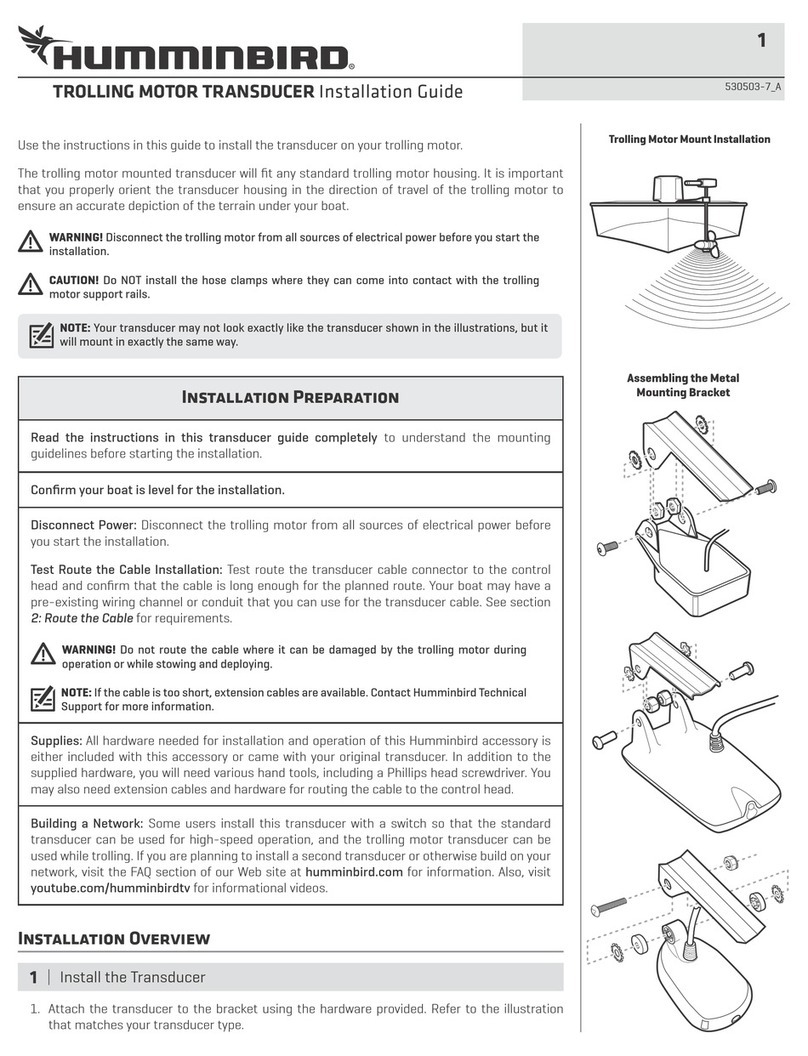
Humminbird
Humminbird TROLLING MOTOR TRANSDUCER installation guide
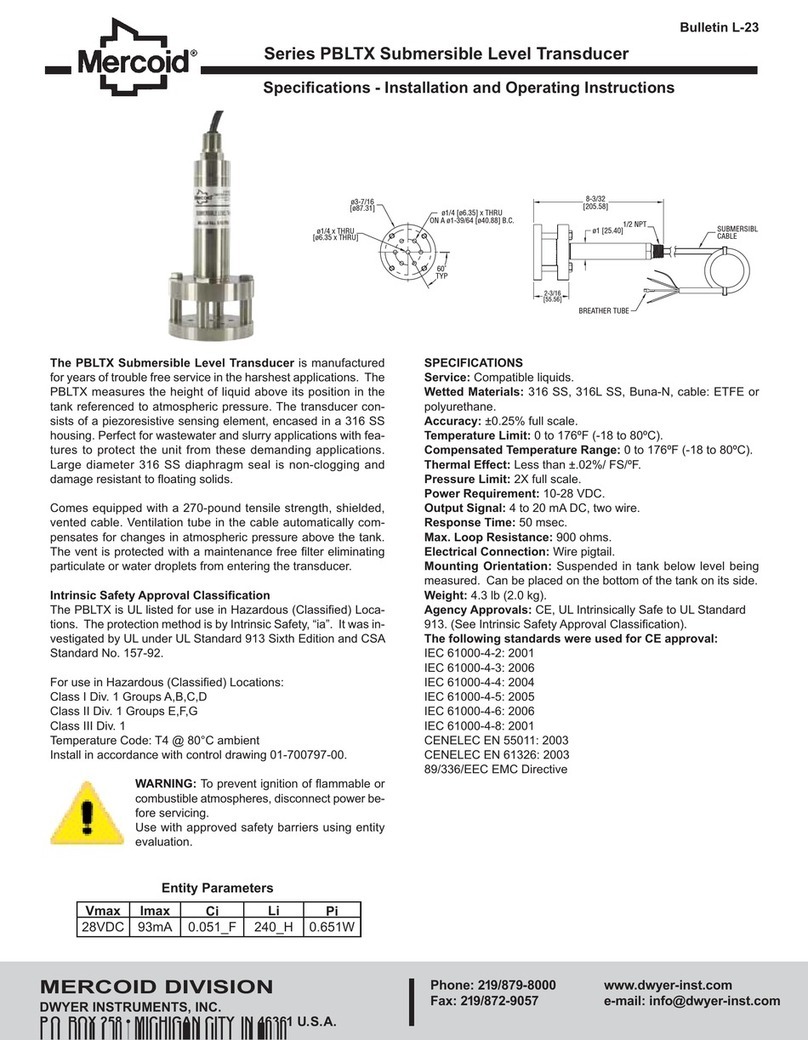
Mercoid
Mercoid PBLTX Series Installation and operating instructions
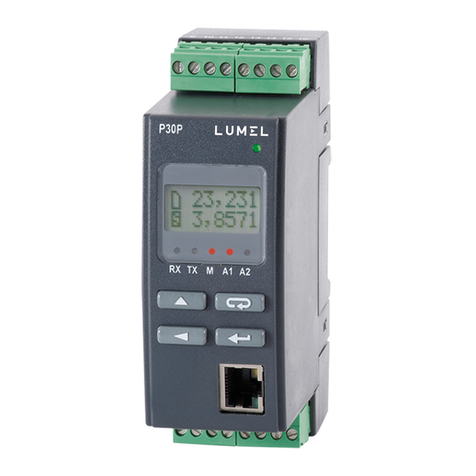
Lumel
Lumel P30P User Manual & Quick Start
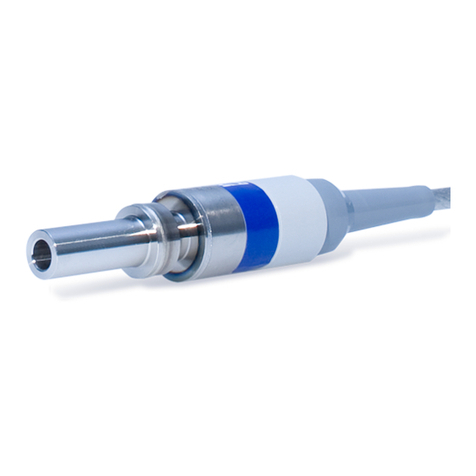
HBM
HBM P8AP operating manual

Barcus-Berry
Barcus-Berry 3110 installation guide
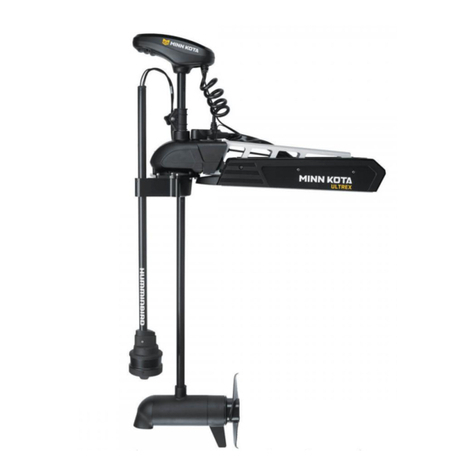
Humminbird
Humminbird MEGA 360 IMAGING Series installation guide

